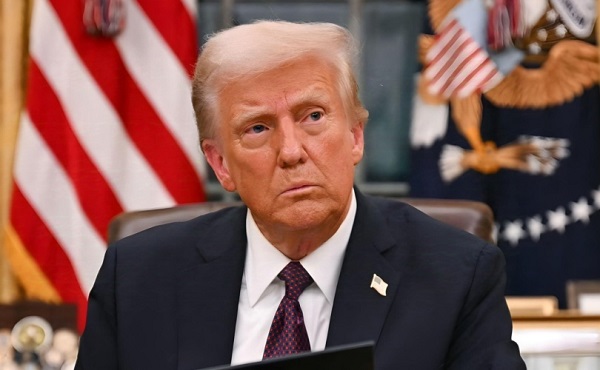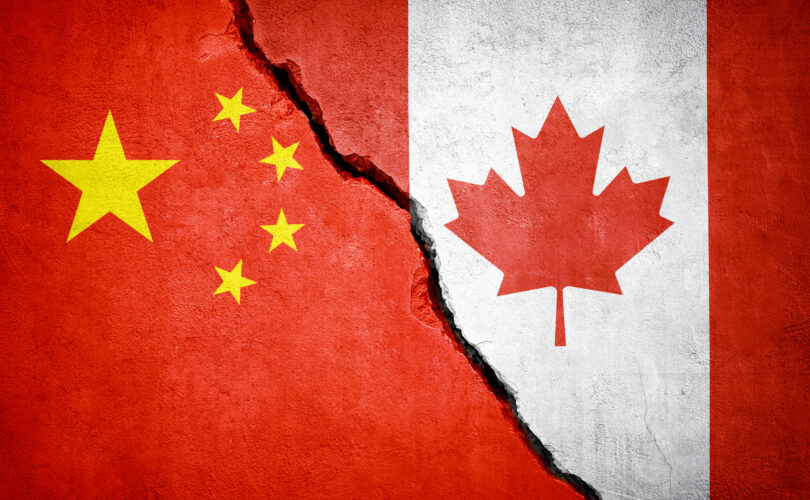Business
Trump’s dismantling of USAID is his biggest blow against the Deep State yet

From LifeSiteNews
By Frank Wright
Elon Musk’s DOGE has shut down USAID, immediately ceasing U.S. government funding of NGOs backing digital tyranny, mass migration, the ‘LGBTQ’ agenda, abortion – and a host of ‘regime change’ operations.
Donald Trump’s new administration has begun to dismantle globalist network funding of the policies of social revolution across the West – and beyond. With the revelations on the shuttering of USAID, Americans now know whose money is behind the Deep State: theirs.
Trump’s war on the Deep State has shocked the establishment. Elon Musk’s DOGE has shut down USAID, immediately ceasing U.S. government funding of NGOs backing digital tyranny, mass migration, the “LGBTQ” agenda, abortion – and a host of “regime change” operations including the funding of the origins of COVID-19 and the impeachment of Donald Trump himself.
These projects, and many more, were all paid for with U.S. taxpayer’s money through USAID.
This Deep State network of finance, influence and the subversion of democracy in the U.S., Britain, Europe and beyond remained unchanged in every election – until this one.
USAID, The U.S. Agency for International Development, “disbursed over 72 billion dollars last year,” according to a Newsweek report in October 2024, which described the now-defunct agency as “by far the world’s largest provider of humanitarian aid.”
So where is this “aid” going?
… and what sort of “humanitarian” projects has it been aiding?
“USAID is notorious for funding the most horrifying projects known to mankind,” as Mike Benz explains.
These projects include apparently funding the origins of COVID-19, “fake social media sites” to promote the overthrow of governments, heroin production and “fake HIV clinics” to promote regime change – as well as funding the prosecution of Americans, and U.S. election interference.
“USAID IS NOTORIOUS FOR FUNDING THE DARKEST, MOST HORRIFYING PROJECTS KNOWN TO MANKIND.” @MikeBenzCyber was shocked to learn about USAID’s role in taking down free speech in America. @AmandaHead @jsolomonReports pic.twitter.com/jWB8FlGoN8
— Real America's Voice (RAV) (@RealAmVoice) February 3, 2025
USAID’s “humanitarian” work included funding and directing the template for global digital governance in Ukraine, with its DIIA app, and funding the World Economic Forum which promotes the same agenda:
🚨🇺🇸 “I found out that USAid has been giving money to support the World Economic Forum”
“Why is the American Tax Payer funding The WEF when everyone that arrives there lands in a private jet” ‼️ pic.twitter.com/OHOdYHIbaL
— Concerned Citizen (@BGatesIsaPyscho) February 4, 2025
Its humanitarian efforts extended to sponsoring anti-Catholic propaganda in Ireland:
As Glenn Beck has pointed out, USAID was a major sponsor of abortion:
USAID is not a "humanitarian" effort. It's a CIA front. It's why the rest of the world HATES us.
In exchange for our tax dollars, we've asked countries to change their laws, accept abortion, promote transgenderism in their schools, open their markets to multinational… pic.twitter.com/eMhLyVhhTi
— Glenn Beck (@glennbeck) February 3, 2025
Here is a picture of ISIS terrorists in Syria in a USAID tent:

USAID was also funding “globalist propaganda” on the U.K.’s state broadcaster:
🚨 BBC FUNDED BY USAID – YOUR TAX DOLLARS FUELING GLOBALIST PROPAGANDA! 🚨
Not content with squeezing Brits dry through a ridiculous TV licence fee, the BBC has ALSO been dipping its hands into U.S. taxpayer money via USAID.
🔴 Hardworking Americans & Brits unknowingly funding… pic.twitter.com/3NQdAFViUC
— Jim Ferguson (@JimFergusonUK) February 4, 2025
Independent journalist Michael Shellenberger reported, “From 2004-2022, USAID was the largest U.S. government funder of EcoHealth Alliance, the group that funded the Wuhan Institute of Virology (WIV), which likely started the COVID pandemic.”
USAID sought to undermine and overthrow traditional and conservative national governments in Eastern Europe – and replace them with liberal-globalist ones:
Dmitry Arestovich, the former right-hand man to Ukraine’s Volodymyr Zelensky, now says USAID pressured the Ukrainian President into the war:
USAID funded “sterilization projects” in Peru:
And as LifeSiteNews reported in December 2024, USAID pressured African nations to change pro-life laws and promote mass abortions, but that did not stop Fr. James Martin from bewailing its demise.
USAID also paid “race rioters” to engage in violent protests in Africa:
At home, USAID sponsored the prosecution of U.S. citizens by “Soros-funded prosecutors”:
…and, as former Trump State Department staffer Mike Benz also asks, “Why did USAID pay $20 million to hit piece journalists to dig up dirt on Rudy Giuliani and use that dirt as the basis to impeach the sitting U.S. President in 2019?”
USAID was also giving “millions of dollars to Bill Kristol,” arch-neocon and founder of the permanent war “Project for a New American Century.”
The populist leader of El Salvador Nayib Bukele summed up the happy ending for the world that is the end of USAID.
“Most governments don’t want USAID funds flowing into their countries because they understand where much of that money actually ends up. While marketed as support for development, democracy, and human rights, the majority of these funds are funneled into opposition groups, NGOs with political agendas, and destabilizing movements.”
He explained how only “maybe 10% of the money reaches real projects that help people in need,” adding that “there are such cases” – but the remaining ninety percent, he says, “It is used to fuel dissent, finance protests, and undermine administrations that refuse to align with the globalist agenda. Cutting this so-called aid isn’t just beneficial for the United States; it’s also a big win for the rest of the world.”
Donald Trump’s war on the Deep State has just begun. It is not merely concerned with saving America, but his “common sense revolution” is a cure for a world made sick by a global network of death, deception and digital tyranny. He is uprooting the hidden international system which has promoted “LGBT, open borders and war” – as Hungary’s Viktor Orbán defined the values of the former regime.
This has been described as a “counter-revolution” by Archbishop Carlo Maria Viganò, who says these are serious moves against the “Deep State… and its mirror image, the Deep Church.”
With a serious campaign underway to destroy the business model of the globalist system it is hard to see how the rainbow “church” of Fr. James Martin can survive its isolation in a world without the patronage, propaganda and power of a corrupt Deep State and its globalist networks.
And the revolution does not stop with USAID. With moves to “purge” the FBI, audit the U.S. Treasury and all the agencies of the U.S. government, Musk’s Department of Government Efficiency is set to undertake a thorough cleanup of the White House and all it commands.
You might say the swamp is being drained.
However you frame it, what is happening here has never been seen in our lifetimes.
The secret state which directed politics and policy in the West despite elections is being exposed, defunded and shut down. We may not only have meaningful elections in future, but a Western society free of the propaganda of social revolution whose toxic “new values” had one thing in mind: the replacement of Christian civilization with a global government no one could ever escape.
Finally, after decades of destruction by design, things have really changed. For good.
Business
DOOR TO DOOR: Feds descend on Minneapolis day cares tied to massive fraud

Federal agents are now going “DOOR TO DOOR” in Minneapolis, launching what the Department of Homeland Security itself describes as an on-the-ground sweep of businesses and day-care centers tied to Minnesota’s exploding fraud scandal — a case that has already burned through at least $1 billion in taxpayer money and is rapidly closing in on Democrat Gov. Tim Walz and his administration.
ICE agents, working under the umbrella of the Department of Homeland Security, fanned out across the city this week, showing up unannounced at locations suspected of billing state and federal programs for services that never existed. One day-care worker told reporters Monday that masked agents arrived at her facility, demanded paperwork, and questioned staff about operations and enrollment.
“DHS is on the ground in Minneapolis, going DOOR TO DOOR at suspected fraud sites,” the agency posted on X. “The American people deserve answers on how their taxpayer money is being used and ARRESTS when abuse is found.”
DHS is on the ground in Minneapolis, going DOOR TO DOOR at suspected fraud sites.
The American people deserve answers on how their taxpayer money is being used and ARRESTS when abuse is found. Under the leadership of @Sec_Noem, DHS is working to deliver results. pic.twitter.com/7XtRflv36b
— Homeland Security (@DHSgov) December 29, 2025
Authorities say the confirmed fraud already totals roughly $300 million tied to fake food programs, $220 million linked to bogus autism services, and more than $300 million charged for housing assistance that never reached the people it was meant to help. Investigators from the FBI, Justice Department, and Department of Labor have now expanded their probes after a viral investigation exposed taxpayer-funded day cares that received more than $1 million each while allegedly serving few — or zero — children.
One of the most glaring examples, the Minneapolis-based Quality “Learing” Center — infamous for its misspelled sign — suddenly appeared busy Monday as national media arrived. Locals told reporters the center is typically empty and often looks permanently closed, despite receiving about $1.9 million in public funds. State inspection records show the facility has racked up 95 violations since 2019. Employees allegedly cursed at reporters while children were bused in during posted afternoon hours.
DHS officials say the “DOOR TO DOOR” operation is deliberate. In videos released online, agents are seen questioning nearby business owners about whether adjacent buildings ever had foot traffic, whether they appeared open, and whether operators used subcontractors or outside partners to pad billing. DHS Secretary Kristi Noem posted footage of agents pressing workers about business relationships and transportation services used by suspected fraud sites.
“This is a large-scale investigation,” DHS Assistant Secretary Tricia McLaughlin told the New York Post, confirming that Homeland Security Investigations and ICE are targeting fraudulent day-care and health-care centers as well as related financial schemes.
FBI Director Kash Patel warned that what investigators have uncovered so far is “just the tip of a very large iceberg.” He pointed to the bureau’s dismantling of a $250 million COVID-era food-aid scam tied to the Feeding Our Future network, a case that resulted in 78 indictments and 57 convictions. Patel has also made clear that denaturalization and deportation remain on the table for convicted fraudsters where the law allows.
Dozens of arrests have already been made across the broader scheme, many involving Somali immigrants, though federal officials stress the investigation targets criminal behavior — not communities. Some local residents say the scandal is hurting law-abiding families. One Somali Uber driver told reporters he works 16-hour days and is furious that “some people are taking advantage of the system,” making the entire community look bad.
Now, with federal agents going “DOOR TO DOOR” across Minneapolis, the era of polite indifference appears to be over. The message from Washington is blunt: the money trail is being followed, the paperwork is being checked, and the days of treating taxpayer-funded programs like an open vault are coming to an end.
Business
Feds pull the plug on small business grants to Minnesota after massive fraud reports

The Small Business Administration is moving to freeze grant money flowing into Minnesota after explosive allegations of large-scale fraud tied to state oversight failures, with SBA Administrator Kelly Loeffler signaling an immediate crackdown following recent independent reporting.
In a series of comments shared publicly by conservative commentator Benny Johnson, Loeffler said the agency is “cutting off and clawing back” SBA grants to the state while investigators dig deeper into what she described as a rapidly expanding fraud network.
Johnson wrote that Loeffler told him she was “disgusted and sickened” after reviewing footage from YouTuber Nick Shirley, whose on-the-ground reporting in Minnesota highlighted what he said were sham daycare and learning centers collecting millions in public funds despite showing little or no sign of legitimate operations.
According to Johnson, Loeffler blamed the situation on Democrat Gov. Tim Walz, accusing his administration of refusing to enforce basic rules governing small businesses and allowing fraud to flourish unchecked.
Johnson said Loeffler told him SBA investigators were able to identify roughly half a billion dollars in suspected fraud within days of focusing on Minnesota, calling the operation an “industrial-scale crime ring” that ripped off American taxpayers.
“Pending further review, SBA is freezing all grant funding to the state in order to stop the rampant waste of taxpayer dollars and uncover the full depth of fraud,” Loeffler said, according to Johnson’s account, adding that the total scope of the scheme remains unknown and could reach into the billions.
The controversy gained national traction after Shirley posted video of himself visiting multiple facilities, including a South Minneapolis site known as the Quality Learning Center, which he reported was approved for federal aid for up to 99 children but appeared inactive during normal business hours.
The center’s sign, Shirley noted, even misspelled the word “learning” as “learing.”
In the footage, a woman inside the building is heard shouting “Don’t open up,” falsely claiming Shirley and his colleague were Immigration and Customs Enforcement agents.
After the video circulated, Rep. Tom Emmer, a Republican, publicly demanded answers from Walz, questioning how such facilities were approved for millions in taxpayer funding.
Shirley’s reporting followed earlier investigations, including a November report by City Journal alleging that members of Minnesota’s Somali community had sent millions of dollars in stolen taxpayer funds overseas, with some of that money reportedly ending up in the hands of Al-Shabaab, a U.S.-designated terrorist organization.
While Walz’s administration has insisted it takes fraud seriously, the SBA’s decision to halt grant funding marks one of the most aggressive federal responses yet, underscoring how rapidly a local scandal has escalated into a national reckoning over oversight, enforcement, and accountability in Minnesota.
-

 Digital ID2 days ago
Digital ID2 days agoCanadian government launches trial version of digital ID for certain licenses, permits
-

 Alberta2 days ago
Alberta2 days agoAlberta Next Panel calls to reform how Canada works
-

 Agriculture2 days ago
Agriculture2 days agoEnd Supply Management—For the Sake of Canadian Consumers
-

 International2 days ago
International2 days agoGeorgia county admits illegally certifying 315k ballots in 2020 presidential election
-

 Business2 days ago
Business2 days agoThe “Disruptor-in-Chief” places Canada in the crosshairs
-

 Artificial Intelligence2 days ago
Artificial Intelligence2 days agoUK Police Pilot AI System to Track “Suspicious” Driver Journeys
-

 Energy1 day ago
Energy1 day ago‘The electric story is over’
-

 International2 days ago
International2 days agoWorld-leading biochemist debunks evolutionary theory






